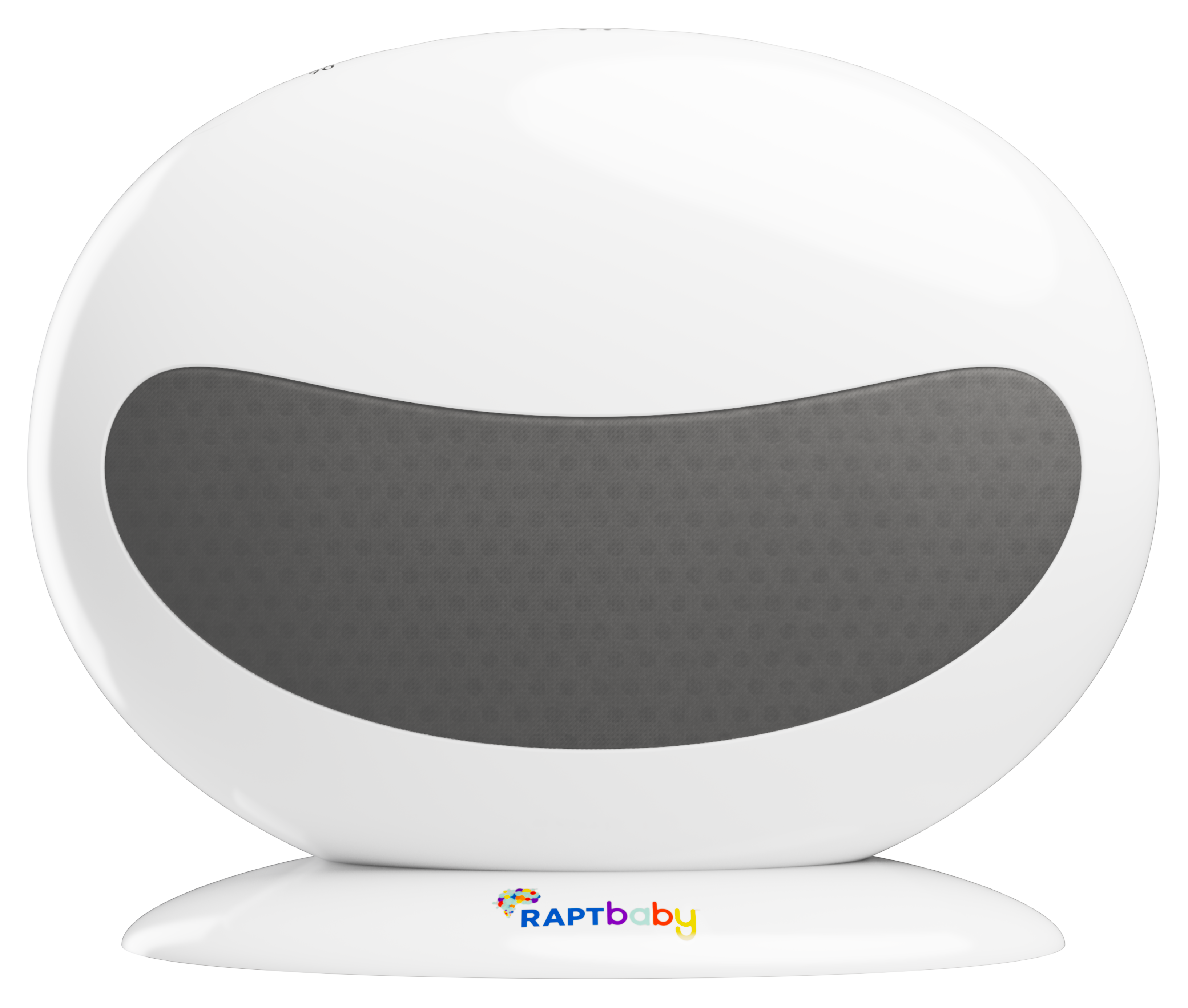R&D at RAPT Ventures: the Power of Plasticity
One of the most important characteristics of the human brain is its plasticity, the ability to reshape itself in response to sensory and experiential interactions with the surrounding environment. Plasticity enables the efficient and accurate development of the neuronal networks that support cognitive function in the young brain and the modification – or re-tuning – of degrading networks in older brains to improve performance.
Brain plasticity is also what allows our products to safely and non-invasively deliver specific auditory stimuli that support the creation and maintenance of strong linguistic neuronal networks that optimize lifelong cognitive performance.
THE PRODUCTS WE CREATE WORK WITH PLASTICITY TO ADDRESS TWO GOALS:
1) Providing acoustic environments that support the creation and maintenance of efficient language networks; and
2) Optimizing rapid auditory processing (“RAP”), the ability to accurately perceive successive rapidly presented sounds, which is central to a newborn’s ability to set up the brain for language and a key factor in the effectiveness with which individuals process language over the course of their lives.
The structured patented algorithms used in our different products translate decades of peer-reviewed and clinically validated research into innovative and accessible consumer applications with the potential for broad-scale benefits for both children and adults.
Providing Supportive Acoustic Environments
The Smarter Sleep sound machine provides an enriched auditory environment developed to support sleep and the brain development that should be happening during sleep. Its background sound envelopes were composed to induce sleep-promoting alpha and delta waves, with structured non-speech auditory cues layered into those envelopes to encourage the brain, even during sleep, to remain attentive to the brief, successive acoustic cues that often signal language is present. Keeping the brain attentive to those sounds facilitates the formation and strengthening of the neuronal connections that are essential to language processing, as they develop in infancy and are used throughout life, including later in life when the degradation of those connections can impair the ability to proficiently process speech sounds.

The Science
Smarter Sleep is based on decades of peer-reviewed, clinical research on: infants’ development of neuronal networks to support language acquisition and processing; the importance that salient acoustic cues play in that process; and the negative impact that auditory environments lacking such cues might have on language development, particularly during sleep.
SUMMARY:
How Children Build Their Brains for Language
The foundation of lifelong cognitive and physical performance is created early in life
As babies grow, they create billions of neuronal connections, establishing networks to perform fundamental brain functions
- Genes set the stage for forming these connections, but environmental input is also essential
- Critical periods are windows in time when infants are especially receptive to specific environmental inputs that help shape their brains (plasticity) and create the networks important to cognitive function
The 1st year is a critical period for language, when an infant builds their acoustic map (the collection of neuronal connections that process the phonemes of their native language)
- Phonemes are the basic units of sound that distinguish words, e.g., in English, the p and b sounds in pad and bad
- To learn language, a child must be able to proficiently analyze and decode phonemes (that occur in the tens of milliseconds) in an incoming sound stream so they can take the steps necessary to acquire language: identifying individual phonemes; recognizing phoneme patterns that make words; and associating words with objects, actions, sensations, etc.
Acoustic maps are shaped through infants’ interaction with their auditory environments
- Auditory cues help brains identify the phonemes that occur most often in their environment (the phonemes of the baby’s primary language)
- Focusing on those phonemes encourages the brain to create precise connections among the individual neurons that fire together in response to each phoneme
- Strong connections create an accurate acoustic map that allows a child to rapidly and automatically process phonemes in an incoming language stream
THE ACCURACY OF A CHILD’S ACOUSTIC MAP IS A VITAL COMPONENT OF THEIR ABILITY TO DECODE, AND ACQUIRE AND USE LANGUAGE
How Acoustic Map Development Can Be Supported
Environmental inputs drive acoustic map formation, but not all inputs are created equal
- Extensive research suggests that infants in suboptimal sound environments, such as high noise settings or ones lacking natural environmental variation, can have disrupted acoustic mapping because of insufficient exposure to the auditory cues the brain is expecting
- Disrupted mapping slows and potentially impairs later language development and processing
The sleep dilemma
- During sleep, certain brain areas are still actively listening for audio cues that generate plasticity and drive the formation of the acoustic map
- Not all infant sleep environments provide those critical stimuli – including those created by many traditional sound machines that can help sleep by masking noise but, as is the case with white noise machines, lack the auditory cues that promote language development
The Smarter Sleep solution
Recognizing the benefits of providing salient acoustic cues to language development during sleep, Smarter Sleep was developed to provide an enriched auditory environment that supports both sleep and language development.
Each of its soundtracks:
- Promotes alpha waves that induce sleep as well as delta waves that encourage deep sleep, and
- Includes structured auditory cues that keep brain areas that should be active during sleep engaged in the development of the neuronal connections so fundamental to efficient language processing
To learn more, download our white paper
Optimizing Rapid Auditory Processing (“RAP”)
RAPT AABy™, an in-home robot currently in development, helps babies improve their RAP and attention skills using RAPT Ventures’ Rapid Auditory Processing Technology (“RAPT™”).
RAPT is a patented adaptive training algorithm that optimizes infants’ RAP skills so that they can establish the accurate and efficient acoustic maps that are needed to support language acquisition, reading and learning. Clinical studies have shown that the auditory processing skills of babies exposed to RAPT for short periods over a several week period were twice as fast as those of untrained babies, and at levels associated with materially better later language and reading scores.

The Science
RAPT AABy and RAPT are based on the work of Dr. April Benasich and were developed in recognition of the foundational importance of rapid auditory processing to language acquisition and cognitive outcomes. RAPT’s design and impact have been validated in numerous peer-reviewed studies.
SUMMARY:
The early ability to discriminate brief, successive acoustic cues through rapid auditory processing (RAP) is one of the core capabilities of the developing brain. In fact, Dr. Benasich’s research has shown that an infant’s RAP ability at six months is highly predictive of scores on language and cognitive performance tests at three and four years old – which themselves have been shown to be strongly associated with lifelong cognitive outcomes. In contrast, infants with weaker RAP skills form poor acoustic maps and can have difficulty learning to read because their brains have trouble matching the appropriate sound to a specific letter. Even as infants mature, and through all stages of adulthood, RAP remains a key cognitive ability, continually supporting the brain’s efforts to maintain strong neuronal connections in its acoustic map so that it can be an effective language processor.
Understanding the immense plasticity of the young brain, Dr. Benasich embarked on a decades long effort to create an interactive audio-visual training algorithm that would optimize RAP by exposing infants to temporally changing acoustic stimuli. The resulting patented technology, RAPT, has been evaluated in numerous peer-reviewed clinical studies, demonstrating, among other findings, that the auditory processing skills of babies exposed to RAPT just once a week for 6 weeks significantly increased their auditory processing speed (these infants were twice as fast as untrained infants). RAPT-trained babies were also faster at syllable recognition and improved their allocation of attention. All of these infant skills have been shown to be significantly related to later language and reading performance.
Selected Supporting Research
Ortiz-Mantilla S, Roesler CP, Realpe-Bonilla T, Benasich AA. Experience-dependent effects of passive auditory exposure in infants impact theta phase synchrony and predict later language. Cereb Cortex. 2023 Mar 25:bhad063. doi: 10.1093/cercor/bhad063. Epub ahead of print. PMID: 36967114.
Ortiz-Mantilla S, Roesler CP, Realpe-Bonilla T, Benasich AA. Modulation of Theta Phase Synchrony during Syllable Processing as a Function of Interactive Acoustic Experience in Infancy. Cereb Cortex. 2022 Feb 19;32(5):919-932. doi: 10.1093/cercor/bhab256. PMID: 34403462; PMCID: 8889996.
Hämäläinen JA, Ortiz-Mantilla S, Benasich A. Change detection to tone pairs during the first year of life – Predictive longitudinal relationships for EEG-based source and time-frequency measures. Neuroimage. 2019 Sep;198:83-92. doi: 10.1016/j.neuroimage. 2019.05.034. Epub 2019 May 16. PMID: 31102736.
Ortiz-Mantilla S, Realpe-Bonilla T, Benasich AA. Early Interactive Acoustic Experience with Non-speech Generalizes to Speech and Confers a Syllabic Processing Advantage at 9 Months. Cereb Cortex. 2019 Apr 1;29(4):1789-1801. doi: 10.1093/cercor/bhz001. PMID: 30722000; PMCID: PMC6418390.
Cantiani C, Ortiz-Mantilla S, Riva V, Piazza C, Bettoni R, Musacchia G, Molteni M, Marino C, Benasich AA. Reduced left-lateralized pattern of event-related EEG oscillations in infants at familial risk for language and learning impairment. Neuroimage Clin. 2019; 22:101778. doi: 10.1016/j.nicl.2019.101778. Epub 2019 Mar 12. PMID: 30901712; PMCID: PMC6428938.
Musacchia G, Ortiz-Mantilla S, Roesler CP, Rajendran S, Morgan-Byrne J, Benasich AA. Effects of noise and age on the infant brainstem response to speech. Clin Neurophysiol. 2018 Dec;129(12):2623-2634. doi: 10.1016/j.clinph.2018.08.005. Epub 2018 Aug 30. PMID: 30241978.
Musacchia G, Ortiz-Mantilla S, Choudhury N, Realpe-Bonilla T, Roesler C, Benasich A.A. (2017). Active auditory experience in infancy promotes brain plasticity in Theta and Gamma oscillations. Developmental Cognitive Neuroscience. 26:9-19. doi: 10.1016/j.dcn.2017.04.004.
Cantiani, C., Riva, V., Piazza, C., Bettoni, R. Moltini, M., Choudhury, N., Marino, C. & Benasich, A.A. (2016). Auditory discrimination predicts linguistic outcome in Italian infants with and without risk for language-learning impairment. Developmental Cognitive Neuroscience, 20, 23-34. doi: 10.1016/j.dcn.2016.03.002.
Benasich, A. A.,Choudhury, N., Peters, S. & Ortiz-Mantilla, S. (2016, Winter). Early Screening and Intervention of Infants at High Risk for Developmental Language Disorders: The Role of Nonlinguistic Rapid Auditory Processing. Perspectives on Language and Literacy, 42 (1), 24–29
Heim, S., Choudhury, N. & Benasich, A.A., (2016). Training-related Changes of Electrocortical Dynamics in Children with a Language-Learning Impairment. Brain Topography, 1-18. PMID: 26671710.
Benasich, A.A.,Choudhury, N.A., Realpe-Bonilla, T., Roesler, C.P. (2014). Plasticity in developing brain: active auditory exposure impacts prelinguistic acoustic mapping. Journal of Neuroscience, 34, 40, 13349-13363. doi: 10.1523/JNEUROSCI.0972-14.2014.
Heim S, Keil A, Choudhury N, Thomas Friedman J, Benasich AA. (2013). Early gamma oscillations during rapid auditory processing in children with a language-learning impairment: Changes in neural mass activity after training. Neuropsychologia, 51, 5, 990-1001. doi: 10.1016/ j.neuropsychologia.2013.01.011. E-pub 2013 Jan 24
Gou, Z., Choudhury, N. & Benasich, A.A. (2011). Resting frontal gamma power at 16, 24 and 36 months predicts individual differences in language and cognition at 4 and 5 years. Behavioral Brain Research, 220, 2, 263-70. doi:10.1016/j.bbr.2011.01.048.
Choudhury, N. & Benasich, A.A. (2011). Maturation of Auditory Evoked Potentials from 6 to 48 months: Prediction to 3 and 4 year Language and Cognitive Abilities. Clinical Neurophysiology, 122, 2, 320-338. doi:10.1016/j.clinph.2010.05.035.
Flax. J. F, Realpe-Bonilla T., Roesler C., Choudhury N, Benasich A. A. (2009). Using early standardized language measures to predict later language and early reading outcomes in children at high risk for language-learning impairments. Journal of Learning Disabilities, 42, 61-75.
Nawyn, J., Roesler, C., Realpe-Bonilla, T., Choudhury, N., Benasich, A. A.(2007). An operantly conditioned looking task for assessing infant auditory processing ability. (Technical Paper) In Proceedings of the 9th International ACM SIGACCESS Conference on Computers and Accessibility. ASSETS ’07, ACM, New York, NY, 147-154.
Benasich, A.A.& Tallal, P. (2002). Infant discrimination of rapid auditory cues predicts later language impairment. Behavioral Brain Research, 136 (1), 31-49.
Benasich, A.A., Thomas, J.J., Choudhury, N. & Leppänen, P.H.T. (2002). The importance of rapid auditory processing abilities to early language development: Evidence from converging methodologies. Developmental Psychobiology, 40, 278-292.
